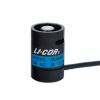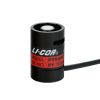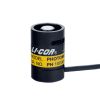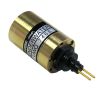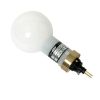LI-COR LI-1500 Light Sensor Logger
Features
- Weather resistant console constructed to withstand impact
- Sample and log measurements up to 500 Hz
- Optional GPS for recording location of measurements
- Free ground shipping
- Expedited repair and warranty service
- Lifetime technical support
- More
Overview
The LI-COR LI-1500 is a light sensor logger with a menu-driven interface, making it easy to use. Attach LI‑COR light sensor(s) to the three BNC connectors. Log manually or use menus to set up one-time, daily, or continual measurement routines. Sampling rates and logging intervals are user-selectable.
Durable
The LI‑1500 features rugged housing and a compact design suitable for handheld outdoor use. A rubber seal between the two halves also serves as a shock cushion. The LI‑1500 is powered by four AA batteries providing over 80 hours of operation with typical usage or 40 hours with the GPS option turned on. Power can also be supplied from an AC wall outlet with the provided USB adapter.
Data Presentation
Graph large data sets using LI‑COR’s FV7x00 software, available for free download. Also, view real-time light measurements, GPS data, and other variables on the eight-line display screen.
Data Storage
The LI‑1500 stores a large amount of logged data on an internal SD card (1 GB of flash memory). Store up to 100 sensor configurations and sensor-specific calibration coefficient information for later use. Download the sensor’s calibration certificate from the LI‑COR website. Enter the calibration coefficient (multiplier) and the date of the last calibration just once. When attached to a computer, the LI‑1500 acts as a mass-storage device with a simple drag-and-drop file system. Logged data can be transferred to a computer with the included USB cable. Data is formatted for easy import. Configurations and sensor calibration data can also be transferred to a computer and then shared with other LI‑1500 units
Connections
Use the LI‑1500 with LI‑COR sensors to log photosynthetically active radiation (PAR), global solar radiation, and light (the visible spectrum). PAR can also be measured along transects under a plant canopy with the LI-1500. Connect up to three sensors at the same time. For instance, use two PAR sensors to measure incident radiation above and below a plant canopy. Features a built-in math function for measuring vertical attenuation using two underwater PAR sensors. The three input ports also allow for the measurement of incident PAR above water while measuring simultaneous upwelling and downwelling PAR below water.
Global Positioning System (GPS)
The LI‑1500 features an optional global positioning system (GPS) for recording the location of measurements. The GPS facilitates repeated visits to the same location for tracking light levels over time. GPS data can be logged independently or with light data.
- (1) LI-1500 light sensor logger
- (4) AA batteries
- (1) USB cable
- (1) AC to DC power supply adapter
- (1) Carabiner clip
- (1) Carrying case
- (1) Instruction manual
In The News
Combating Water Insecurity in Saskatchewan with Real-Time Data
The prairies of Saskatchewan can be described as one of the least water-secure parts of Canada, making water quality monitoring essential for informed resource management in a region already facing water insecurity. While natural physical properties worsen some of the poor water quality conditions in the region, others are connected to land use. Having grown up spending summers on the shores of Lake Huron, Helen Baulch, an associate professor at the School of Environment and Sustainability at the University of Saskatchewan , has always been dedicated to the protection of water resources. Looking back fondly at her childhood playing along the shore, Baulch also recalls the invasion of quagga mussels during her teenage years and watching the lake change as a result.
Read MoreSeametrics Turbo Turbidity Logger: Boost your Turbidity Monitoring
The Seametrics Turbo Turbidity Logger is a self-cleaning turbidity sensor capable of internally logging over 260,000 data records. The sensor enables researchers, compliance officers, and contractors to monitor turbidity in various applications, from construction and dredging sites to wastewater effluent. Due to its narrow width, this device can be deployed in a range of areas, from small well spaces to rivers and streams. The stainless steel housing and built-in wiper allow the sensor to withstand long-term deployments and reduce the need for maintenance trips. The logger accurately records temperature and turbidity up to a depth of 50 meters.
Read MoreCollecting Data at the Top of the World: How Scientists Retrieve Glacial Ice Cores
A helicopter touches down in the small town of Sicuani, Peru, at an elevation of 11,644 feet. Earlier that day, a boxcar brought fuel, drills, food, and other equipment for a glacial expedition. The year is 1979, and glaciologist Lonnie Thompson is preparing to lead a team to the Quelccaya ice cap in hopes of becoming the first scientists to drill an ice core sample from this glacier. The only problem? The glacier is located at 19,000 feet in one of the most remote areas of the world. The helicopter takes off from the town, but the thin atmosphere at that elevation does not allow it to safely touch down on the ice– due to the aircraft’s weight, and it becomes unstable when the air is less dense.
Read More





























